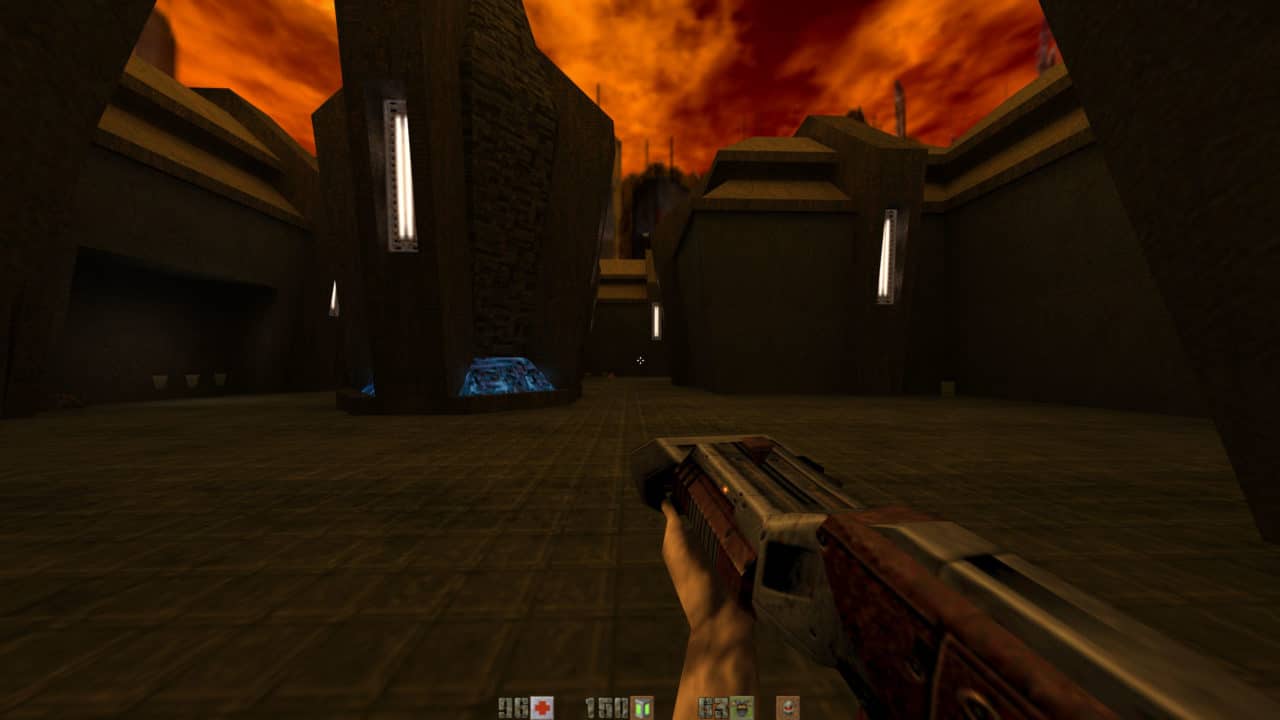

It was a foregone conclusion that with the additions to the engine, Quake II‘s gameplay would also see a boost. And much like what PlayStation fans experienced with 3d games, Quake II had its own graphical “warbling” effect, which was something of an endearing feature for the engine.

Still, we were in awe, and fancy new things like coloured lighting helped to spice things up. Though to be fair, years before Gears of War hit the scene, Quake II provided ample shades of brown throughout its palette, which looking back now, looks washed out. The Quake II engine not only had the ability to push more polygons, but also render far more colours than its grimly dark predecessor. Obviously, much of these enhancements found in the engine were thanks to John Carmack, who once again proved himself a genius in the programming department. You could solve that easily by turning enemies into bloody chunks before they got the chance, which was satisfying for the hell you were put though. You also had enemies that would have a “last ditch” death animation, such as a Guard firing off a few rounds at you before collapsing. To add even more of an aesthetic touch to the Strogg, you now had damage states depending on the amount of damage you had dealt, resulting in them looking progressively more bloodied. Or the Berserker that always seemed to be positioned behind doors to surprise you, yelling “Trespasser!” before running after you relentlessly to attempt to stab and hammer you to death. For example, the Parasite would attach a “tongue” to you and start draining your energy, and wouldn’t let go until you killed it. Overall, you also had far more variety in enemy types than in Quake II, which displayed the fusion of flesh and machine in rather gruesome details. They also had idling animations that provided more personality. Along with providing each enemy type with different AI tendencies and patterns, you also had some Strogg be able to duck under your shots or run and hide to regroup, requiring you to have some strategy while making your way through levels. The Strogg are a concoction of biomechanical monstrosities that harvest human soldiers to add to their own ranks, which is just as chilling as any cosmic horror.Īlongside their formidable appearance, it was the smaller touches added to the Strogg that gave Quake II much more appeal. The Gothic horror and Lovecraftian overtones of the original have been left behind for a more sci-fi action horror epic, and really, that’s still very much okay. And while it’s not comparable to something as engrossing as other video game stories of the day (it’s still a first-person shooter, after all), you did have something that was far better than than what the original game offered. You had objectives like destroying the Strogg security grid, realigning satellite dishes, and so on. No longer were you searching for keys to open doors to progress. With Quake II, gone was the hub world and episodic nature of the levels, and in their place was a much more mission-driven story and less linear level structure. That was just the start of one of the differences between Quake II and its predecessor. Aside form that, the development was far smoother. Quake II had sort of followed in its footsteps, having started out as something else, but eventually having the “Quake” name attached to it. Having to salvage the idea of a dark fantasy RPG and turning it into a first-person shooter led to frictions within id, and resulting in Romero’s departure. Looking back, Quake‘s development was a bit of a mess. Exiting your capsule, you head into the Strogg city, blaster in hand. Fortunately, you survive the entry to Stroggos due to another Marine’s personal capsule collided with yours, causing you to crash outside of the landing zone.

Previous attempts to send Marines to the planet resulted in them being captured or killed as soon as they reached the planned landing zone. The mission is to prevent a Strogg invasion of Earth by launching a pre-emptive attack against their home planet, Stroggos. You are a Marine named Bitterman taking part in a mission known as “Operation Alien Overlord”. In Quake II, Earth is in a battle against an alien race known as the Strogg. The story for Quake II is separate from the previous game’s story. That opportunity resulted in Quake II being Aliens when compared to the original Alien: bigger, more fun, and just as memorable as the original after 25 years. As such, you could say that the team was given the opportunity to try something new.
QUAKE II THE RECKONING SOFTWARE
Long-time id Software member John Romero had departed the company, along with many of the staff who had worked on the first game. Much like Doom 2 was to Doom, how do you follow up the mega success that was Quake? The obvious answer was Quake II, but there’s a little more to it than that.


 0 kommentar(er)
0 kommentar(er)
